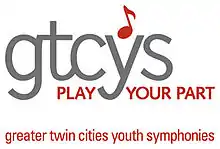Greater Twin Cities Youth Symphonies
The Greater Twin Cities Youth Symphonies (GTCYS) is a group of youth orchestras in the Twin Cities in Minnesota. Founded in 1972, GTCYS has served over 16,000 musicians and put on more than 500 concerts. The top orchestra has also traveled on 12 national and international tours.[1] GTCYS currently features 9 orchestras for young musicians any age through high school.
Greater Twin Cities Youth Symphonies | |
|---|---|
 | |
| Background information | |
| Origin | Twin Cities, Minnesota, USA |
GTCYS is a youth orchestra program based in the Greater Twin Cities metro that draws over 600 students from eastern Minnesota and western Wisconsin. Its artistic director is Mark Russell Smith, who also conducts the top orchestra, Symphony. History: Founded in 1972.
In 2011, GTCYS and the SPCO formed a strategic partnership to serve the community through music and build classical music audiences.
Orchestras
As of the 2020/21 season, there are ten orchestras starting from the rudimentary level. All of the orchestras require an audition which will place the instrumentalist into an orchestra that meets their playing needs. The only exception are the two Summer Orchestras that play and meet during the Summer which do not require an audition. Halfway through the Fall/Spring semester there is a Winter Audition for students who wish to participate for the last half of the GTCYS year.
- The first orchestra level is the Philharmonia East and Philharmonia West.
This orchestra is split between East and West locations for rehearsals and performances. These orchestras do not have any woodwind, brass, or percussion instruments.
- The second tier are Sinfonia East and Sinfonia West.
This orchestra involves Brass, Percussion, and Woodwinds. The auditions are more difficult and require harder audition pieces and more scales.
- The third tier is Concertino East and Concertino East.
This orchestra involves Brass, Percussion, and Woodwinds. The auditions now become more difficult and require harder audition pieces and more scales.
- The fourth tier is Camerata .
This orchestra involves Brass, Percussion, and Woodwinds. The auditions now become slightly more difficult and require harder audition pieces and more scales.
The top three Orchestras are Concert Orchestra (Mark Gitch), Philharmonic (Gary Wolfman), and Symphony (Mark Russell Smith). All orchestras include a full range of Brass, Woodwinds and Percussion, and focus on more advanced music with a large range music from contemporary to the classics.
- Concert Orchestra is the lowest of the high.
This orchestra is the lowest to regularly play unedited works for orchestra.
- Philharmonic is second only to Symphony.
In this orchestra, students begin to tackle the more difficult works in the professional orchestral repertoire.
- Symphony is the most advanced group.
It has the most advanced set of music and players. This orchestra has the opportunity to travel internationally biennially.
Concerts have been performed at notable venues in the Twin Cities such as Orchestra Hall, Ted Mann Concert Hall, and the Ordway Center for the Performing Arts. GTCYS orchestras have also performed around the world, in such venues as the Sydney Opera House, and the Krzysztof Penderecki European Centre for Music in Poland. Symphony, the flagship orchestra, traveled to Spain during the spring of 2014 by invitation to the Granada International Festival of Music and Dance. In 2016, Symphony travelled to Argentina with major concerts in Buenos Aires, Rosario, and Santa Fe. In 2018, Symphony travelled to Germany, Poland, and Hungary with major concerts in Wrocław, Kraków, the Krzysztof Penderecki European Centre for Music, and Budapest. The orchestra also had the opportunity to attend a concert by the Berlin Philharmonic, and participated in a workshop with Berlin Philharmonic cellist Stephan Koncz while in Germany. In June 2021, Symphony will travel to Southern Italy, postponed from June 2020 due to the ongoing COVID-19 pandemic.
References
- "The Greater Twin Cities Youth Symphonies". Archived from the original on 2008-01-05. Retrieved 2008-01-25.